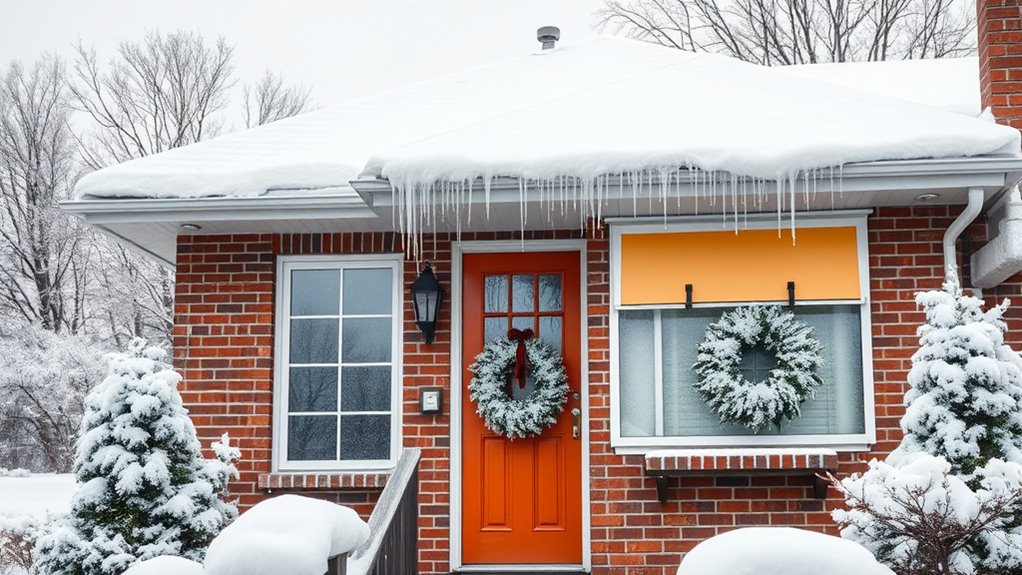To winterize your home for energy savings, start by inspecting and sealing windows and doors to prevent drafts. Add insulation to your attic and walls to keep indoor temperatures stable. Service your heating system and replace filters regularly to guarantee efficiency. Seal any leaks and install weatherstripping or door sweeps. Prepare your fireplace and outdoor faucets to avoid damage. Finally, optimize your thermostat settings for comfort and savings. Keep going to discover detailed tips for each step.
Key Takeaways
- Seal leaks around windows, doors, and electrical outlets to prevent drafts and heat loss.
- Add insulation to attic and walls to improve thermal efficiency and reduce energy bills.
- Maintain HVAC systems and replace filters regularly for optimal performance and energy savings.
- Install weatherstripping and door sweeps to block cold air infiltration and enhance home comfort.
- Prepare outdoor faucets and chimneys to prevent damage and ensure safe, efficient heating during winter.
Inspect and Seal Windows and Doors

As winter approaches, it is vital to inspect your windows and doors for drafts and leaks. Feel around the edges for cold air slipping through, and listen for whistling sounds. Check the weatherstripping and caulking for cracks or gaps. If you find any, remove old, damaged material and replace it with new weatherstripping or sealant. Pay close attention to areas where frames meet walls, as these spots are common leak points. Ensuring a tight seal keeps warm air inside and cold air out, reducing your heating bills. Don’t forget to test door sweeps at the bottom of exterior doors. Properly sealing these gaps now prevents heat loss and creates a more comfortable home during winter. Additionally, inspecting for drafts and leaks can help identify unseen areas where warm air escapes, boosting your energy savings even further. Using insulation materials in problem areas can further enhance your home’s energy efficiency during colder months. Installing thermal curtains can also add an extra layer of insulation, helping to maintain heat inside your home. For added protection, consider installing window insulation kits to improve overall insulation performance.
Add Insulation to Attic and Walls
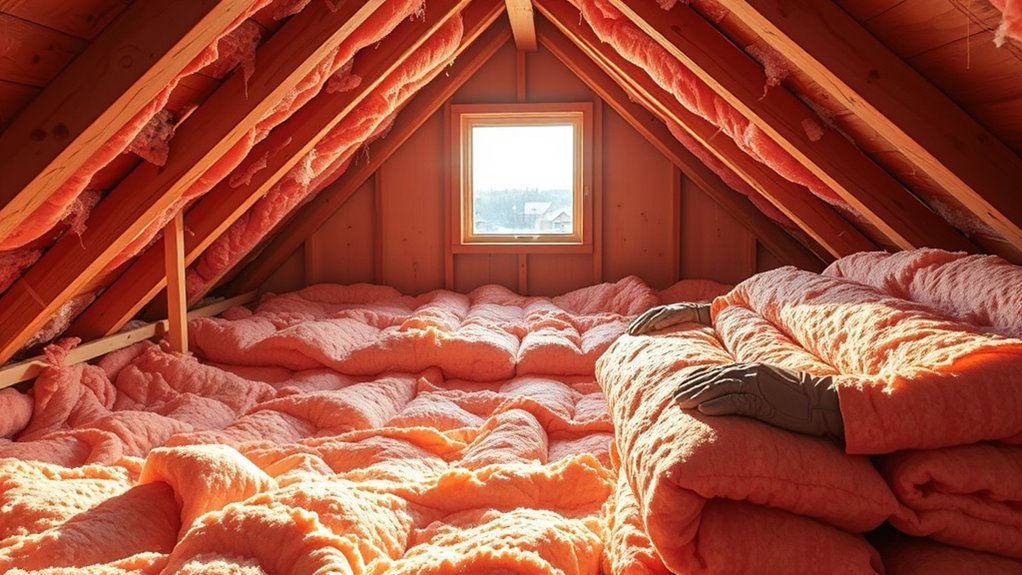
Adding insulation to your attic and walls can greatly boost your home’s energy efficiency and comfort during winter. You’ll want to think about different types of attic insulation and the best methods for installing wall insulation. Let’s explore how these upgrades can make a real difference and how to do them right. Using the proper insulation materials can enhance thermal performance and reduce energy costs effectively. To ensure optimal results, consider consulting guidelines for proper installation techniques that maximize insulation effectiveness. Building a strong emotional safety within your home can encourage more open communication about energy needs and comfort. Incorporating the right insulation strategies can further optimize your home’s energy savings during colder months. Being aware of regional resources can help you choose the most suitable materials and methods for your area’s climate and building codes.
Benefits of Additional Insulation
Installing extra insulation in your attic and walls can substantially reduce your heating and cooling costs by improving the energy efficiency of your home. With added insulation, you create a better barrier against outdoor temperatures, keeping warm air inside during winter and outside during summer. This means your heating system works less, lowering your energy bills. Additionally, extra insulation helps maintain a consistent indoor temperature, reducing hot or cold spots. It also minimizes drafts and prevents heat loss through gaps and cracks. Over time, the savings on energy costs can offset the initial investment in insulation. Plus, enhanced insulation contributes to a quieter home and can improve indoor air quality by reducing drafts that let in dust and allergens. Properly installed insulation materials are essential for maximizing these benefits. In colder months, additional insulation can be especially effective at reducing heat loss and maintaining comfort. Effective insulation also plays a role in vetted product reviews, ensuring you select the best options for your home improvements. Furthermore, choosing the right type of insulation can enhance both thermal performance and soundproofing. Incorporating energy-efficient techniques can further optimize your home’s insulation effectiveness and savings. Overall, extra insulation offers significant comfort and financial benefits.
Types of Attic Insulation
Choosing the right type of attic insulation depends on your home’s needs, climate, and budget. Common options include fiberglass batts, which are easy to install and cost-effective, making them ideal for DIY projects. Spray foam provides superior air sealing and higher R-values, but it’s more expensive and often requires professional installation. Blown-in cellulose is great for filling gaps and existing insulation, offering good fire resistance and eco-friendliness. Mineral wool is fire-resistant and damp-proof, suitable for more demanding environments. Natural materials like cellulose and mineral wool are popular choices for environmentally conscious homeowners. Additionally, selecting insulation with appropriate thermal resistance can significantly impact energy efficiency. Proper insulation also helps prevent air leaks, which can undermine insulation effectiveness. Using insulation with proper R-values ensures optimal thermal performance. Consider your home’s specific requirements, insulation R-value, and your budget to select the most appropriate type. Proper insulation helps keep heat in during winter, reducing energy costs and increasing comfort.
Wall Insulation Installation Tips
To guarantee your home stays warm and energy-efficient, properly adding insulation to your walls and attic is essential. Begin by inspecting existing insulation to identify gaps or compressed areas. For wall insulation, consider blown-in cellulose or fiberglass, which can be added through small holes drilled into the wall cavities. Make sure to seal any leaks or cracks before installing new insulation to prevent drafts. When installing insulation, wear protective gear to avoid irritation from fibers. Keep consistent coverage, filling gaps and avoiding compression, which reduces effectiveness. For best results, follow manufacturer instructions regarding R-values and installation depth. Proper insulation not only keeps your home warmer but also reduces your energy bills by minimizing heat loss. Additionally, understanding home improvement principles can help you maximize space and organization, making your home more comfortable and energy-efficient. Remember that energy conservation techniques, such as sealing leaks and adding insulation, are key components of an effective winterization strategy. Incorporating proper ventilation can also prevent moisture buildup and maintain indoor air quality. Ensuring your insulation is properly installed enhances the overall thermal performance of your home, leading to better energy savings.
Service Your Heating System

To keep your heating system running efficiently, you should schedule proper maintenance checks before winter hits. Make sure to replace filters regularly to improve airflow and indoor air quality. These simple steps can help prevent breakdowns and keep your home warm all season long.
Proper Maintenance Checks
Before cold weather hits, it is essential to have your heating system inspected and serviced. Proper maintenance checks ensure your system runs efficiently and prevents costly breakdowns. Start by scheduling a professional inspection to identify issues like worn belts or dirty components. Next, have your technician verify that all electrical connections are secure and functioning properly. Finally, ask for a thorough cleaning of the blower motor and heat exchanger to improve airflow and heat transfer. These steps help your system operate at peak performance and extend its lifespan. Regular maintenance not only keeps your home warm but also reduces energy consumption. Don’t wait until a cold snap to address potential problems—schedule your service now for reliable heating all winter.
Replacing Filters Regularly
Replacing filters regularly is one of the simplest ways to keep your heating system running efficiently. When filters are clogged with dust and debris, your system has to work harder, increasing energy use and wear. Check your filters every month during winter, and replace them at least every three months, or more often if you have pets or allergies. A clean filter improves airflow, maintains consistent heating, and reduces strain on your system. It also helps prevent dust and allergens from circulating in your home. To replace a filter, turn off your system, remove the old filter, and insert a new one with the correct size and direction. Regular filter changes keep your system functioning smoothly and save you money on energy bills.
Seal Leaks and Drafts Around Your Home
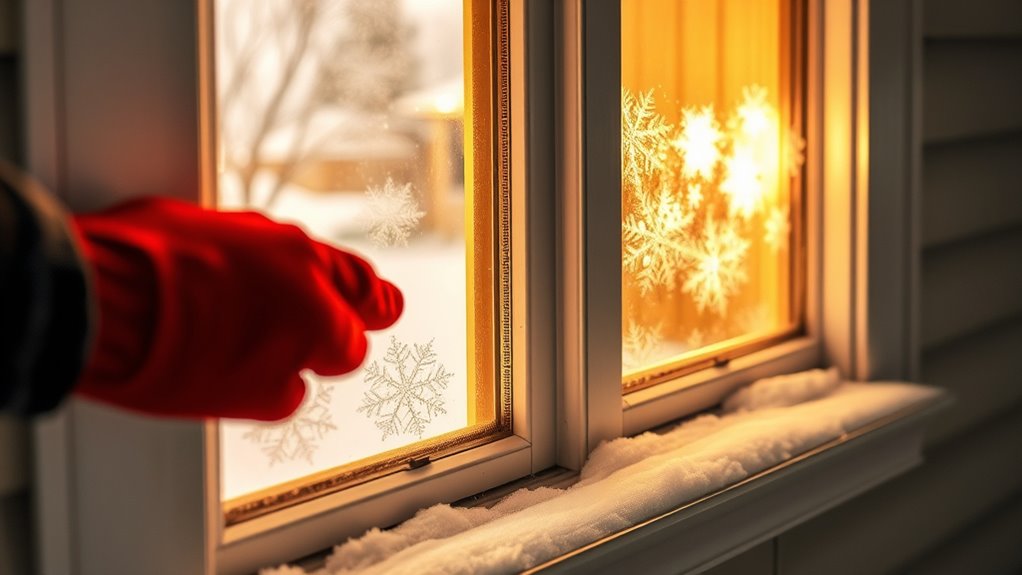
Leaking gaps and drafts can substantially decrease your home’s energy efficiency during winter. To keep warmth in and cold out, inspect your home carefully. Here are three quick fixes:
- Check around windows and doors for gaps; seal them with weatherproof caulk or expanding foam.
- Use draft stoppers or draft snakes on door bottoms to prevent chilly air from sneaking in.
- Inspect electrical outlets and switch plates; install foam gaskets to block drafts.
Sealing these leaks reduces heat loss, lowers your heating bills, and makes your home more comfortable. Don’t overlook small gaps—they can add up to significant energy waste. Taking these simple steps can make a big difference in maintaining a cozy, energy-efficient home all winter.
Install Weatherstripping and Door Sweeps
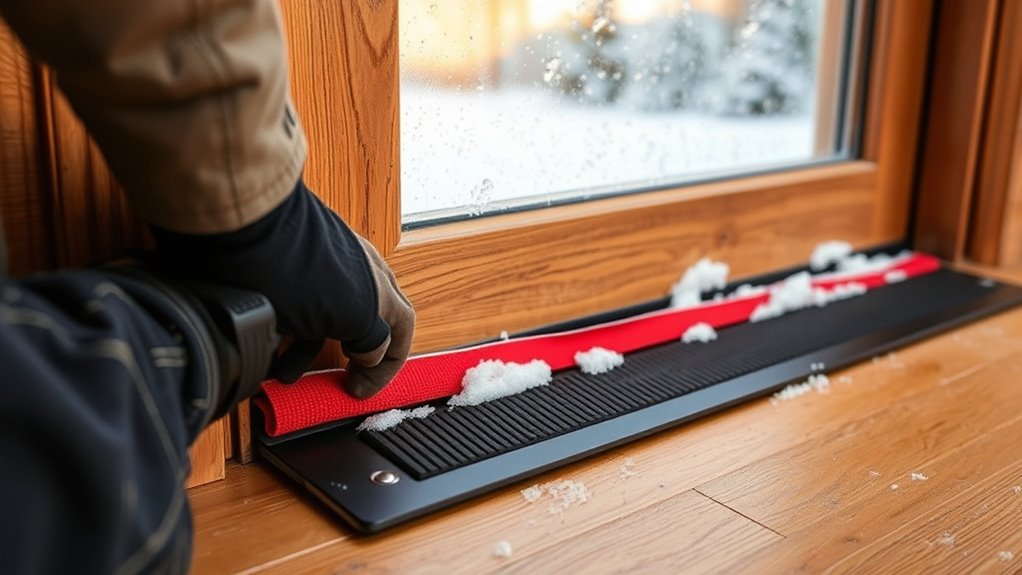
Installing weatherstripping and door sweeps is one of the most effective ways to block drafts and improve your home’s energy efficiency this winter. Start by inspecting gaps around your doors and windows, then choose the appropriate weatherstripping material—foam, rubber, or vinyl—that fits your needs. Apply it along the edges where air leaks occur, ensuring a snug seal. For doors, install a door sweep at the bottom to prevent cold air from slipping underneath. Measure carefully to avoid gaps or overlaps. Ensure all seals are secure and flush with the surface for maximum effectiveness. Doing so reduces heat loss, lowers heating bills, and keeps your home warmer and more comfortable throughout the season. A simple upgrade with weatherstripping makes a noticeable difference in winter energy savings.
Prepare Your Fireplace and Chimney

Before the cold weather sets in, make sure to prepare your fireplace and chimney to guarantee safe and efficient operation. First, have your chimney professionally inspected and cleaned to remove creosote buildup and check for blockages or damage. Second, inspect your fireplace damper to ensure it opens, closes, and seals properly; repair or replace it if needed. Third, remove any debris, such as leaves or nests, from the chimney cap and surrounding area to prevent obstructions. Taking these steps reduces fire hazards, improves airflow, and enhances heating efficiency. Regular maintenance keeps your fireplace safe and ready for use during winter, so you can enjoy cozy fires without worry. Proper preparation is key to safe, energy-efficient warmth all season long.
Protect Outdoor Faucets and Pipes
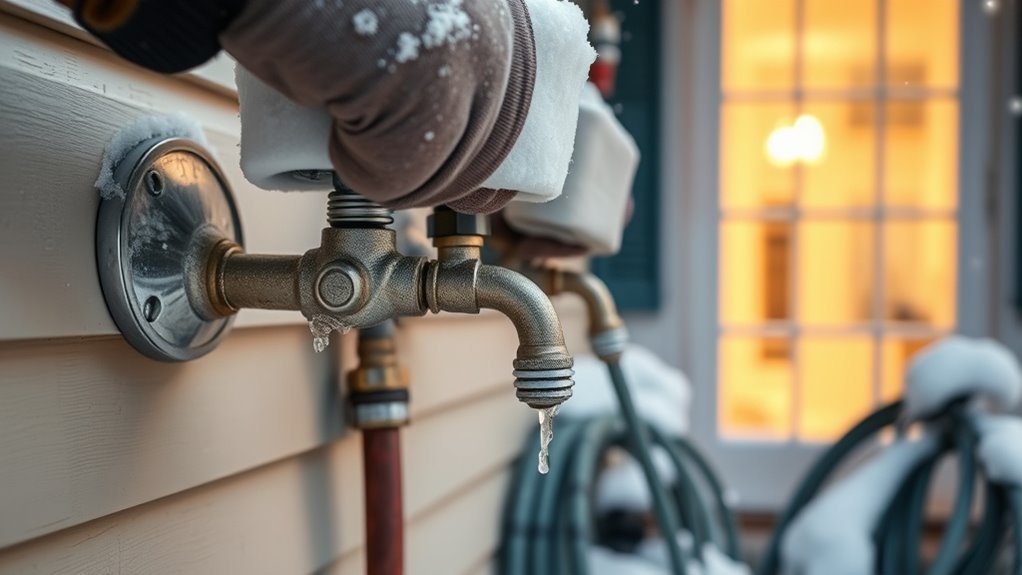
As temperatures drop, it’s essential to protect your outdoor faucets and pipes from freezing and bursting. Start by disconnecting hoses and draining leftover water to prevent pressure buildup. Install faucet insulators or foam covers to shield vulnerable areas. For exposed pipes, use foam pipe insulation or wrap them with heating tape for extra protection.
| Outdoor Faucet | Protected With |
|---|---|
| Hose attachment | Disconnected, drained, insulated |
| Exposed pipes | Foam insulation or heating tape |
| Faucet spigot | Insulated cover or faucet sock |
| Benefits | How it helps |
| Prevents freezing damage | Stops pipes from bursting |
| Saves on repair costs | Avoids costly plumbing repairs |
| Maintains water flow | Keeps outdoor water functional |
Optimize Your Home’s Thermostat Settings
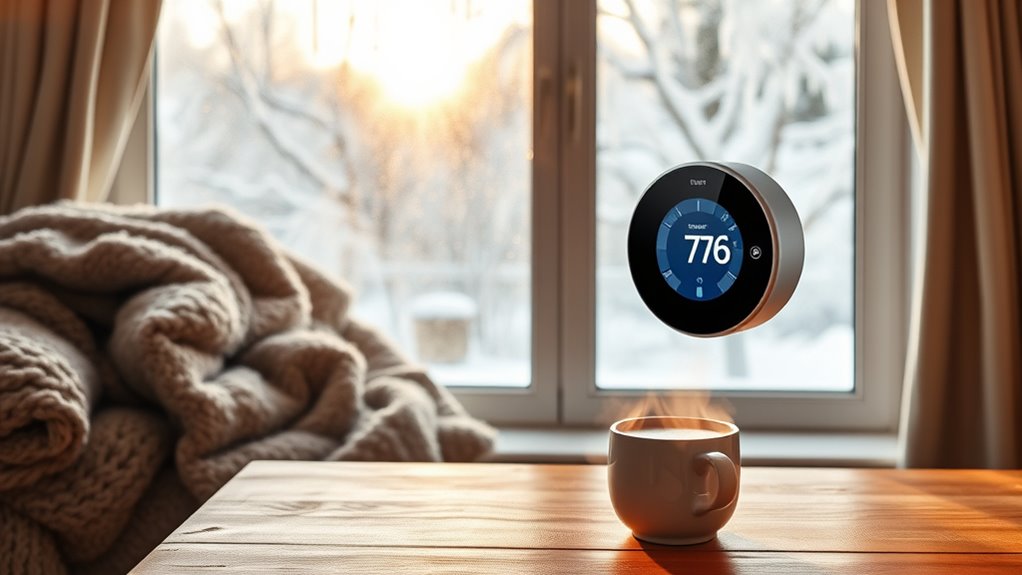
Adjusting your thermostat settings strategically can considerably boost your home’s energy efficiency and keep your living space comfortable throughout the winter. Start by setting your thermostat to around 68°F when you’re home and awake. When you’re asleep or away, lower it by 7-10°F to save energy. Consider these tips:
- Use a programmable thermostat to automatically adjust temperatures based on your schedule.
- Avoid setting the thermostat higher than necessary; higher settings won’t heat your home faster.
- Keep vents and radiators unobstructed to ensure even heat distribution.
Frequently Asked Questions
How Often Should I Inspect My Home’S Insulation?
You should inspect your home’s insulation at least once a year, ideally before the cold weather sets in. Check for any signs of damage, compression, or moisture that could reduce its effectiveness. If you notice gaps or settling, add or replace insulation to maintain energy efficiency. Regular inspections help you identify issues early, ensuring your home stays warm and your energy bills stay manageable.
What Are Signs My Heating System Needs Repair?
Think of your heating system as the beating heart of your home. If you notice uneven warmth, strange noises, or a persistent smell, it’s a sign something’s wrong. Frequent cycling or higher energy bills also hint at repairs needed. Don’t ignore these signs; addressing them early keeps your home cozy and prevents small issues from snowballing into costly repairs. Stay attentive, and your system will keep your home warm and welcoming.
Which Areas Are Most Prone to Drafts?
You should check common draft spots to make your home more comfortable. The areas most prone to drafts include windows, especially around frames and sills, and doors, including gaps beneath and around them. Electrical outlets on exterior walls can also let in cold air. Don’t forget chimneys and attic hatches, which can leak heat. Sealing these gaps with weatherstripping or caulk can markedly reduce drafts and improve energy efficiency.
How Do I Choose the Right Weatherstripping?
When choosing the right weatherstripping, you need to contemplate the specific area you’re sealing. For gaps around doors and windows, select foam tape for easy installation or V-strip for larger gaps. For moving parts like doors, consider tubular rubber or silicone. Measure the gap accurately, and opt for durable, weather-resistant materials. Remember, the right weatherstripping will improve energy efficiency and keep drafts out effectively.
When Is the Best Time to Seal Outdoor Faucets?
You should seal outdoor faucets before the temperatures drop consistently below freezing, typically in late fall. This prevents water from freezing inside the pipes, which can cause damage. Check your local weather forecast and seal your faucets once nighttime temperatures stay around 20°F (-6°C). Doing this early guarantees your pipes stay protected throughout the winter, saving you from costly repairs and energy waste.
Conclusion
By winterizing your home, you’re wrapping it in a warm, cozy blanket against the cold. Each step you take is like locking out icy drafts and sealing in comforting heat. Imagine your home as a fortress of warmth, standing strong and snug through the chilly months. With these simple measures, you’ll keep the cold at bay and your energy bills in check, turning your house into a haven of warmth and savings all winter long.
